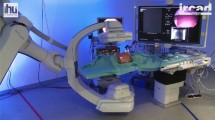Abstract
Robotic surgery has reached a very high level of advancement, in particular, Da Vinci Xi robotic system allows the execution of surgical tasks of the highest precision. It offers advantages in terms of reduced blood loss, reduced postoperative hospital stay, and less postoperative pain. The disadvantage the surgeon has found is progressive tactile loss, a long training curve and very high cost. This can be overcome by using Augmented Reality and trying to combine the advantages of this technology. In AR-based applications, the key challenge is to ensure the highest degree of realism in blending computer-generated elements with the surgical scene. To implement new AR protocols and be able to perform pre-clinical tests without having to use the complex and expensive robotic vision system, it was decided to design a stereo endoscope laboratory mock-up (SELM), which reproduces the Da Vinci vision tool, so as to be able to have the instrument in any bioengineering laboratory. This paper presents our new vision system, that has stereoscopic vision, 5.5 mm diameter camera, 1280 × 720 resolution, 7–40 cm depth of field, 80° angle of view, and real-time imaging up to 30 fps. These data compared with the technical characteristics of the endoscope present in the Da Vinci Xi robotic system makes it possible to state that the use of this endoscope can replace in terms of visual quality, the endoscope of the Da Vinci and thus the development time of new robotic techniques and AR is less, compared to the classical realization of in vitro tests to be performed in robotic operating rooms.
Access this chapter
Tax calculation will be finalised at checkout
Purchases are for personal use only
Similar content being viewed by others
References
Robotic Surgery. https://www.forbesindia.com/article/brand-connect/robotic-surgery/70551/1
D’Ettorre, C., et al.: Accelerating surgical robotics research: a review of 10 years with the da Vinci research kit. IEEE Robot. Autom. Mag. 28(4), 56–78 (2021)
Da Vinci intuitive surgical – Procedures, da Vinci Surgery (2020). https://www.davincisurgery.com/. Accessed 10 Aug 2020
Freschi, C., et al.: Technical review of the da Vinci surgical telemanipulator. Int. J. Med. Robot. Comput. Assist. Surg. 9(4), 396–406 (2013)
Venkatesan, M., et al.: Virtual and augmented reality for biomedical applications. Cell Rep. Med. 2(7) (2021)
Samset, E., et al.: Augmented reality in surgical procedures. In: Human Vision and Electronic Imaging XIII, vol. 6806, p. 68060K. International Society for Optics and Photonics, February 2008
Lungu, A.J., Swinkels, W., Claesen, L., Tu, P., Egger, J., Chen, X.: A review on the applications of virtual reality, augmented reality and mixed reality in surgical simulation: an extension to different kinds of surgery. Expert Rev. Med. Dev. 18(1), 47–62 (2021)
Specifications for the da Vinci Xi Robotic Surgery system. https://www.wbhealth.gov.in/uploaded_files/notice/UROLOGY/Da%20vinci%20Xi%20robotic%20surgery%20set.pdf
720P USB Endoscope, 5.5mm Type-C Snake Inspection Camera 16.5ft. https://depstech.com/en-eu/collections/usb-endoscopes/products/usb-endoscope-86t-1mp
Mamone, V., et al.: Low-computational cost stitching method in a three-eyed endoscope. J. Healthc. Eng. 2019, 5613931 (2019). https://doi.org/10.1155/2019/56139318.
Ferrari, V., et al.: Augmented reality visualization of deformable tubular structures for surgical simulation. Int. J. Med. Robot. Comput. Assist. Surg. (2015)
Chen, D., et al.: A 3D stereo system to assist surgical treatment of prostate cancer. In: Workshop of International Conference on Medical Image Computing and Computer Assisted Intervention, pp. 9–17 (2008)
The Retroprojection Error? https://www.camcalib.io/post/what-is-the-reprojection-error
Hu, X., Baena, F.R.y., Cutolo, F.: Head-mounted augmented reality platform for markerless orthopaedic navigation. IEEE J. Biomed. Health Inform. 26(2), 910–921 (2022). https://doi.org/10.1109/JBHI.2021.3088442
Qian, L., Wu, J.Y., DiMaio, S.P., Navab, N., Kazanzides, P.: A review of augmented reality in robotic-assisted surgery. IEEE Trans. Med. Robot. Bionics 2(1), 1–16 (2020). https://doi.org/10.1109/TMRB.2019.2957061
Acknowledgment
We acknowledge the support of the European Union by the Next Generation EU project ECS00000017 ‘Ecosistema dell’Innovazione’ Tuscany Health Ecosystem (THE, PNRR, Spoke 9: Robotics and Automation for Health), and the Italian Ministry of Education and Research (MUR) in the framework of the FoReLab and CrossLab projects (Departments of Excellence).
Author information
Authors and Affiliations
Corresponding author
Editor information
Editors and Affiliations
Rights and permissions
Copyright information
© 2023 The Author(s), under exclusive license to Springer Nature Switzerland AG
About this paper
Cite this paper
Mendicino, A.R., Bani, E., Caretto, M., Cutolo, F., Simoncini, T., Ferrari, V. (2023). A Cheap and Powerful Stereo Endoscope Lab Mock-Up for Robotic Surgery to Implement and Test Machine Vision and Augmented Reality Prototypes. In: De Paolis, L.T., Arpaia, P., Sacco, M. (eds) Extended Reality. XR Salento 2023. Lecture Notes in Computer Science, vol 14219. Springer, Cham. https://doi.org/10.1007/978-3-031-43404-4_24
Download citation
DOI: https://doi.org/10.1007/978-3-031-43404-4_24
Published:
Publisher Name: Springer, Cham
Print ISBN: 978-3-031-43403-7
Online ISBN: 978-3-031-43404-4
eBook Packages: Computer ScienceComputer Science (R0)




